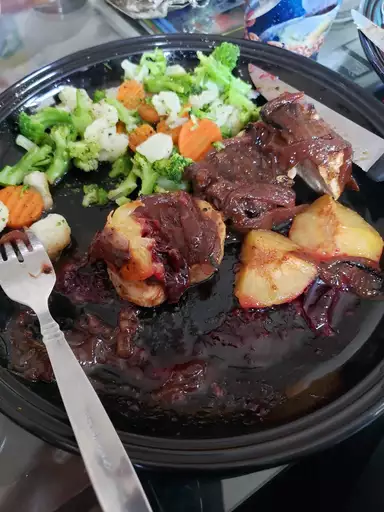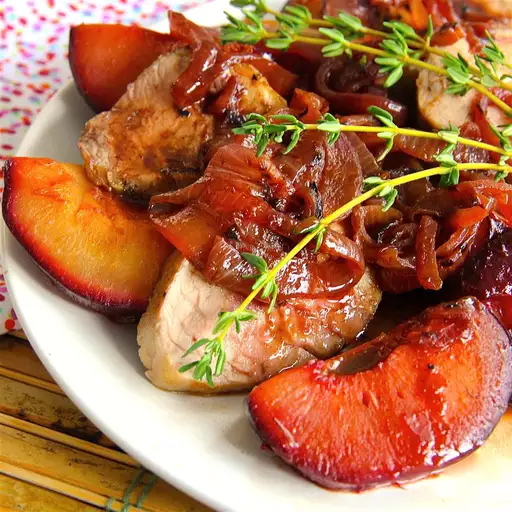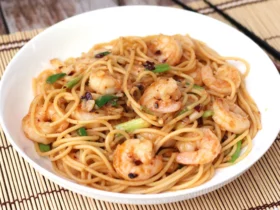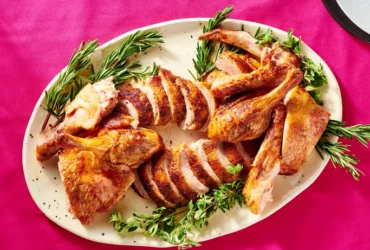Background and History
Roasted pork tenderloin with fresh plum sauce combines the succulence of pork with the sweet tang of ripe plums. While the exact origins of this dish are unclear, pork and fruit pairings have been a culinary tradition in many cultures for centuries. This recipe offers a delightful blend of flavors, perfect for both casual family dinners and elegant gatherings.

Recipe Guide
Serves
- 4 people
Time
- Total preparation time: 15 minutes
- Marinating time: 30 minutes (optional)
- Cooking time: 25 minutes
Ingredients
- 1 pork tenderloin (about 1 lb)
- 4 ripe plums, pitted and chopped
- 2 tablespoons soy sauce
- 2 tablespoons honey
- 2 cloves garlic, minced
- 1 tablespoon grated fresh ginger
- 2 tablespoons olive oil
- Salt and pepper to taste
- Fresh parsley or green onions for garnish (optional)
Instructions
Marinate the Pork (Optional)
- In a shallow dish, combine soy sauce, honey, minced garlic, grated ginger, salt, and pepper.
- Place the pork tenderloin in the marinade, turning to coat evenly. Cover and refrigerate for at least 30 minutes, or up to 4 hours for maximum flavor.
Preheat the Oven
- Preheat your oven to 400°F (200°C).
Prepare the Plum Sauce
- In a saucepan, combine the chopped plums with a splash of water.
- Cook over medium heat until the plums break down and become soft, stirring occasionally.
- Use a fork or potato masher to mash the plums into a chunky sauce.
- Stir in honey to taste, then remove from heat and set aside.
Roast the Pork
- Heat olive oil in an ovenproof skillet over medium-high heat.
- Remove the pork from the marinade (if marinated) and discard excess marinade.
- Sear the pork tenderloin on all sides until browned, about 2-3 minutes per side.
- Transfer the skillet to the preheated oven and roast for about 15-20 minutes, or until the internal temperature reaches 145°F (63°C) for medium-rare or 160°F (71°C) for medium.
Rest and Serve
- Remove the pork from the oven and let it rest for 5-10 minutes before slicing.
- Slice the pork tenderloin into medallions and serve with the fresh plum sauce.
- Garnish with chopped fresh parsley or green onions if desired.
Nutrition Facts (per serving)
- Calories: 250
- Protein: 25g
- Carbohydrates: 15g
- Fat: 10g
- Saturated Fat: 2g
- Fiber: 2g
- Sugar: 12g
- Sodium: 400mg
Notes
- If you prefer a smoother sauce, you can puree the plum mixture in a blender or food processor before adding honey.
- Feel free to adjust the sweetness of the plum sauce by adding more or less honey according to your taste preference.
- This dish pairs well with roasted vegetables, rice, or mashed potatoes.
Allergy Warning
- Soy sauce may contain gluten, so individuals with gluten sensitivities should use gluten-free soy sauce.
- Check for potential allergens in store-bought plum sauce, such as additives or preservatives.
Should pork tenderloin be seared before roasting?
Searing pork tenderloin before roasting helps to lock in juices and adds flavor by caramelizing the surface. While it’s not strictly necessary, it can enhance the overall taste and texture of the dish.
What do you do with plum sauce?
Plum sauce can be used as a condiment or glaze for various dishes, including roasted pork tenderloin, grilled chicken, or duck. It adds a sweet and tangy flavor that complements savory dishes beautifully.
Is it better to cook pork tenderloin fast or slow?
Pork tenderloin is best cooked quickly over high heat or roasted at a moderate temperature. Slow cooking methods like braising or stewing are not suitable for pork tenderloin as they can result in a tough texture.
Does pork tenderloin need to be trimmed before cooking?
Pork tenderloin typically comes trimmed and ready to cook. However, it’s a good idea to check for any excess fat or silverskin and trim it off before cooking to ensure a tender and flavorful result.
What should be removed from pork tenderloin before cooking?
Before cooking, you should remove any excess fat or silverskin from the pork tenderloin. This helps to prevent the meat from becoming tough and ensures even cooking.
Do you wash pork tenderloin before cooking?
It’s generally not recommended to wash pork tenderloin or any raw meat before cooking. Washing can spread bacteria around your kitchen and increase the risk of foodborne illness. Cooking pork tenderloin to the proper internal temperature is the best way to ensure its safety.
Is there a difference between pork loin and pork tenderloin?
Yes, there is a difference between pork loin and pork tenderloin. Pork loin is a larger cut of meat that comes from the back of the pig, while pork tenderloin is a smaller, leaner cut that comes from the muscle that runs along the backbone. Pork loin is often used for roasts, while pork tenderloin is more commonly used for quick-cooking methods like grilling or pan-searing.
What color should pork tenderloin be when fully cooked?
When fully cooked, pork tenderloin should have an internal temperature of 145°F (63°C) for medium-rare or 160°F (71°C) for medium. The meat should have a slight blush of pink in the center and be firm to the touch.
How long to soak pork in water before cooking?
Soaking pork in water before cooking is not necessary and can actually increase the risk of bacterial contamination. It’s best to handle pork safely by cooking it to the proper internal temperature rather than soaking it in water.
What happens if you don’t wash pork before cooking?
If you don’t wash pork before cooking, there should be no negative consequences. Washing raw meat before cooking is not recommended as it can spread bacteria and increase the risk of foodborne illness. Cooking pork to the proper internal temperature is the most effective way to ensure its safety.
- Best Lusha Alternatives for 2025 - April 22, 2025
- Best Overloop Alternatives for 2025 - April 22, 2025
- Best 6sense Alternatives for 2025 - April 22, 2025














